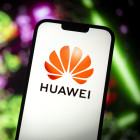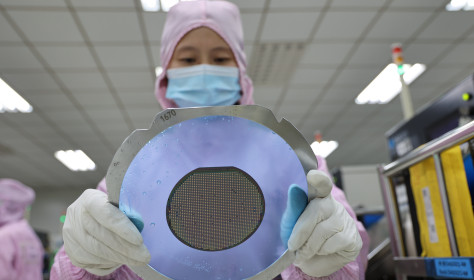
Semiconductors
Semiconductors are crucial to many of China’s strategic goals: digitalizing the economy, boosting high-tech exports such as electric vehicles (EVs) and solar panels, and developing modern weapons. With its state-led “Big Fund,” China has invested more than CNY 686 billion (EUR 87.5 billion) into the industry since 2014, in addition to local government support and private investment.
Indigenizing the semiconductor industry has gained urgency, as US sanctions and export controls have cut off access to advanced semiconductors critical for development in AI, military and other fields.
Since the US sanctioned the telecoms giant Huawei in 2019, Huawei has quietly become the central force in the state’s effort to develop homegrown chips, alongside other companies. China is a major producer of semiconductors using older manufacturing technology and is a leader in backend processes – chip assembling, testing, and packaging. But it lags in making advanced semiconductors and lacks the tools to manufacture them. US export controls have cut off access to critical foreign-made equipment.
Nevertheless, leading manufacturer SMIC has produced an advanced 7nm smartphone chip and a line of AI chips, both for Huawei. Taiwan’s TSMC, the world’s leading semiconductor contract manufacturer, first pioneered a 7nm process in 2018 (has since produced several rounds of further innovations), suggesting SMIC lags by roughly five years. However, China’s lack of access to Extreme Ultraviolet Lithography (EUV) machines, essential for making advanced semiconductors and exclusively produced by the Netherlands’ ASML, may hamper further progress.
Graphics dashboard
Semiconductor fabs rely on many different types of machines. To fully indigenize production, China would need to produce all these machines. They are often not easily interchangeable. Even though Chinese firms currently have a market share of 11 percent in etching, their machines often cannot be used to replace foreign ones.
The first two rounds of China’s Big Fund semiconductor investment fund were focused on costly IC manufacturing. The latest and largest round of 344 billion CNY (44 billion EUR), announced in May 2024, is expected to focus on AI chips and high-end equipment, where China urgently needs self-sufficiency in the face of US export controls.
Venture capital usually flows to companies with low capital requirements. The semiconductor industry needs significant capital investment for entry and therefore was not a focus of Chinese venture capital activities until 2018/2019. At that time, Huawei was targeted by US sanctions, and more and more companies bought into the government’s self-reliance drive.
Semiconductors in China: Timeline of crucial events
The US adds Huawei and its subsidiaries to the Entity List, restricting exports to them. This impacts Huawei's supply chain, with 33 of its 92 core suppliers based in the US.
US applies Foreign Direct Product Rule to Huawei, blocking its technology access globally. Companies are barred from using US technology (mainly semiconductors) to supply Huawei.
Top Chinese scientist suggests China use open-source RISC-V chip design architecture to overcome Western sanctions, and create an ecosystem around “RISC-X” in Belt and Road countries.
US expands export controls on advanced semiconductors and manufacturing equipment, restricting tech specs of chips and including arms-embargoed countries.
Huawei and SMIC release Kirin 9000S, a 7nm 5G chip for Huawei's latest high-end smart phone – even after US export controls blocked equipment considered necessary to make such chips.


Second tranche of Big Fund raises CNY 2 trillion (EUR 25.6 billion) to support Chinese semiconductor industry – beyond just fabs – to create an ecosystem for making semiconductors in China.
COVID-19 severely disrupts supply chains for automotive chips. Car companies must cut output due to the shortage. Chinese chip companies evolve to meet the demand of its auto industry.
US institutes country-wide semiconductor export controls, a major policy shift that restricts all of China’s access to "chokepoint" technologies, not just certain entities.
Third phase of China Integrated Circuit Industry Investment Fund (Big Fund III) raises CNY 3.4 trillion (EUR 44.3 billion) from state-owned investors for semiconductor industry, the largest to date.
Technology progress
- Smartphone maker Xiaomi claimed to have successfully completed the final ("tape-out") stage for China's first domestically designed 3nm mobile system-on-chip. The chip is set to be produced at Taiwan’s TSMC, although US restrictions could affect this. (Source CN: EE Times China)
- Chinese automakers Nio and Xpeng are moving toward designing their own autonomous driving chips and customized software architecture. The Chinese market for these sophisticated chips is currently dominated by Tesla and Nvidia (Source CN: 36 Kr)
- Huawei’s new flagship smartphone will not be equipped with its state-of-the-art Kirin 9100 chip, suggesting yield issues persist on their production. It will instead feature a less advanced 9020 chipset for the high-end models, and the older 9010 for the basic model. (Source EN: TrendForce)
- A team at Beida published a new way to grow crystals for semiconductors in the international science magazine “Science.”. (Source: S&T Daily, July 7)
Domestic dynamics
- The cost of renting Nvidia’s H100 AI chip in China for use from cloud service providers has dropped, pointing to both supply and demand stabilizing in the AI industry after the initial rush to build datacenters and large AI models. (Source CN: 36 Kr)
- Four large industry associations representing the most important semiconductor consumers advised their companies to be cautious when using US chips due to supply chain security concerns after the US published new export restrictions on semiconductors. (Source CN: CLS)
- China’s government is urging domestic automakers to purchase 25% of their chips locally by 2025. While these guidelines are not mandatory, they follow a line of announcements to that effect, including Xi Jinping asking a company CEO whether he already sources his chips domestically (Source: EETimes, May 17)
- The third tranche of the Big Fund is starting to invest. First investments went to Hua Hong Semiconductors, while strategically, the fund will invest more in AI-relevant chips. (Source: Zhidx, 36kr, June 9)
International involvement
- The US Commerce Department announced additional restrictions on sales of chips and equipment to China, with a focus on high-bandwidth memory for AI chips. 140 Chinese entities were added to the Entity List. (Source EN: Bloomberg)
- Intel announced a USD 300 million expansion of its packaging and testing facility in Chengdu, demonstrating commitment to the country only weeks after a state-linked cybersecurity group called for a security review of Intel’s products. (Sources EN: TrendForce, Nikkei Asia)
- After Nvidia again revamped its China offerings to follow US export controls in 2023, Chinese companies are now choosing domestic offerings more frequently. Huawei, Baidu Kunlun and Moore Thread are all offering chips that are cheaper, while still being good enough. (Source: Caijing, Caijing, July 8)
- More than 50% of Japanese semiconductor manufacturing equipment exports go to China. Surrounding US export restrictions, Chinese companies have ramped up buying of semiconductor manufacturing companies, to prepare for possible stricter controls in the future. (Source: 36kr, June 12)



